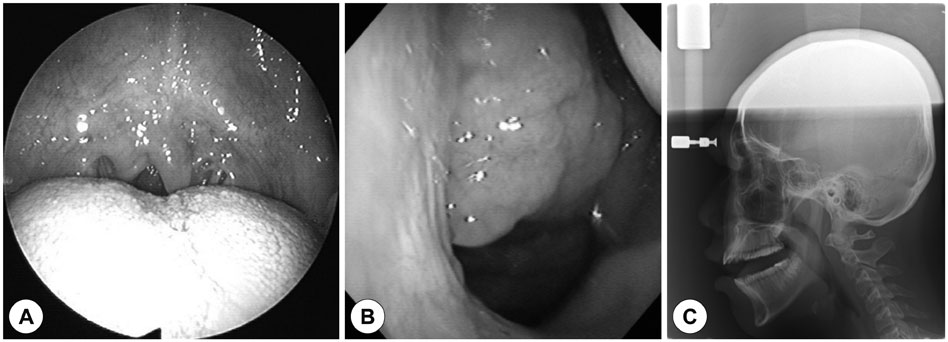J Rhinol.
2017 May;24(1):52-55. 10.18787/jr.2017.24.1.52.
Two Cases of Pediatric Obstructive Hypoventilation Managed with Upper Airway Surgery
- Affiliations
-
- 1Department of Otorhinolaryngology-Head and Neck Surgery, College of Medicine, Korea University Ansan Hospital, Ansan, Korea. shleeent@korea.ac.kr
- KMID: 2379791
- DOI: http://doi.org/10.18787/jr.2017.24.1.52
Abstract
- Sleep-disordered breathing in children can include habitual snoring, obstructive hypoventilation, upper airway resistance syndrome, and obstructive sleep apnea. Obstructive hypoventilation in children is characterized by COâ‚‚ retention caused by prolonged partial upper airway obstruction during sleep. To date, there have been few studies regarding the clinical significance and management strategies in pediatric obstructive hypoventilation, although it is a unique feature of pediatric sleep-disordered breathing. In this report, we describe two cases of obstructive hypoventilation that demonstrated improvement following upper airway surgery. These results suggest that upper airway surgery could be an additional treatment modality in obstructive hypoventilation.
MeSH Terms
Figure
Reference
-
1. Mo JH. Obstructive sleep apnea and systemic diseases. J Rhinol. 2013; 20(1):8–13.2. Marcus CL. Pathophysiology of childhood obstructive sleep apnea: Current concepts. Respir Physiol. 2000; 119(2-3):143–154.
Article3. Berry RB, Budhiraja R, Gottlieb DJ, Gozal D, Iber C, Kapur VK, et al. Rules for scoring respiratory events in sleep: Update of the 2007 AASM Manual for the Scoring of Sleep and Associated Events. Deliberations of the Sleep Apnea Definitions Task Force of the American Academy of Sleep Medicine. J Clin Sleep Med. 2012; 8(5):597–619.4. Khan SR, Strollo PJ. Therapy of hypoventilation. Semin Respir Crit Care Med. 2009; 30(3):359–366.
Article5. Borel JC, Borel AL, Monneret D, Tamisier R, Levy P, Pepin JL. Obesity hypoventilation syndrome: From sleep-disordered breathing to systemic comorbidities and the need to offer combined treatment strategies. Respirology. 2012; 17(4):601–610.
Article6. Gozal D, O'Brien LM. Snoring and obstructive sleep apnoea in children: why should we treat? Paediatr Respir Rev. 2004; 5:Suppl A. S371–S376.
Article7. Sinha D, Guilleminault C. Sleep disordered breathing in children. Indian J Med Res. 2010; 131:311–320.8. Chervin RD, Ruzicka DL, Giordani BJ, Weatherly RA, Dillon JE, Hodges EK, et al. Sleep-disordered breathing, behavior, and cognition in children before and after adenotonsillectomy. Pediatrics. 2006; 117(4):E769–E778.
Article9. Mun YG, Rhee CS. Surgical Management of Obstructive Sleep Apnea Syndrome. J Rhinol. 1994; 1(2):123–130.10. Shintani T, Asakura K, Kataura A. The effect of adenotonsillectomy in children with OSA. Int J Pediatr Otorhinolaryngol. 1998; 44(1):51–58.
Article11. Marcus CL. Sleep-disordered breathing in children. Am J Respir Crit Care Med. 2001; 164(1):16–30.
Article12. Katz ES, D'Ambrosio CM. Pathophysiology of pediatric obstructive sleep apnea. Proc Am Thorac Soc. 2008; 5(2):253–262.
Article13. Marcus CL, Lutz J, Carroll JL, Bamford O. Arousal and ventilatory responses during sleep in children with obstructive sleep apnea. J Appl Physiol. 1998; 84(6):1926–1936.
Article14. Piper AJ, Grunstein RR. Obesity hypoventilation syndrome: mechanisms and management. Am J Respir Crit Care Med. 2011; 183(3):292–298.15. Olson AL, Zwillich C. The obesity hypoventilation syndrome. Am J Med. 2005; 118(9):948–956.
Article
- Full Text Links
- Actions
-
Cited
- CITED
-
- Close
- Share
- Similar articles
-
- Upper airway myofunctional exercise: a systematic review
- Upper airway studies in patients with obstructive sleep apnea syndrome
- A Case of Severe Obesity-Hypoventilation Syndrome Treated by Bilevel Positive Airway Pressure Therapy
- Developmental Characteristics of Upper Airway Anatomy in Pediatric Obstructive Sleep Apnea
- CPAP Treatment in Pediatric Obstructive Sleep Apnea



